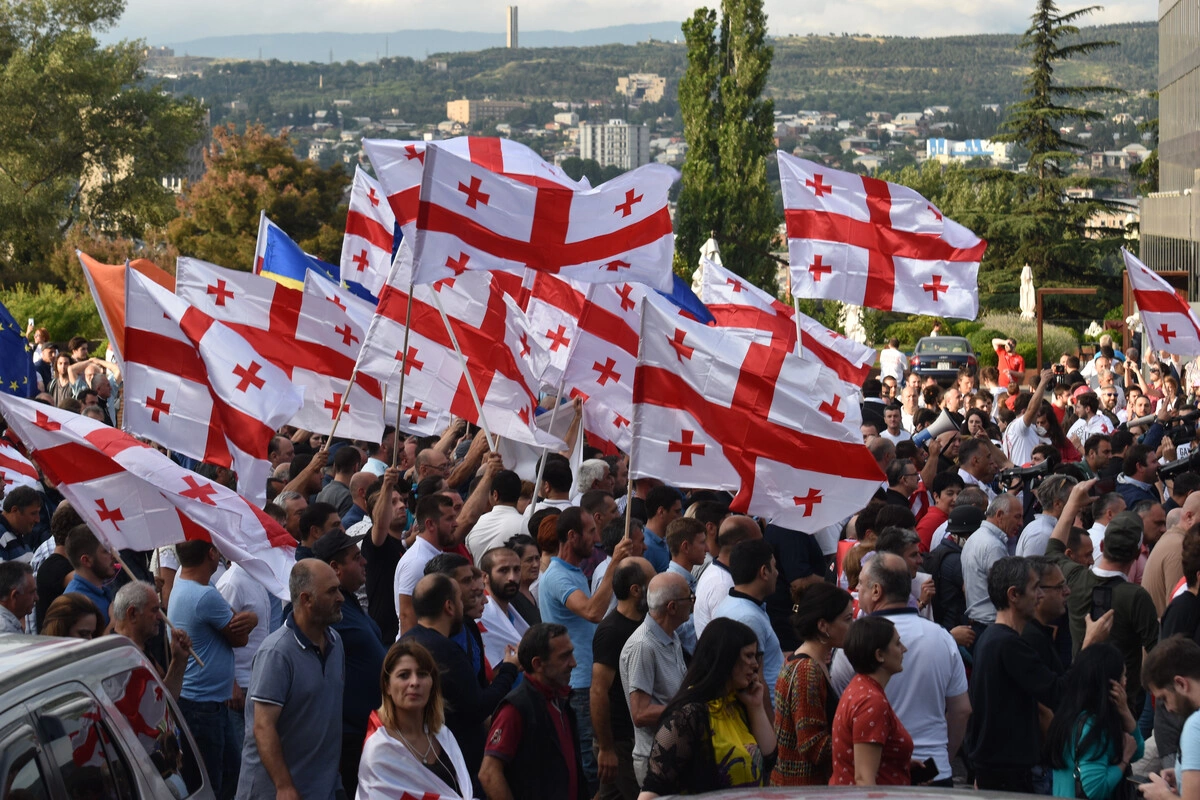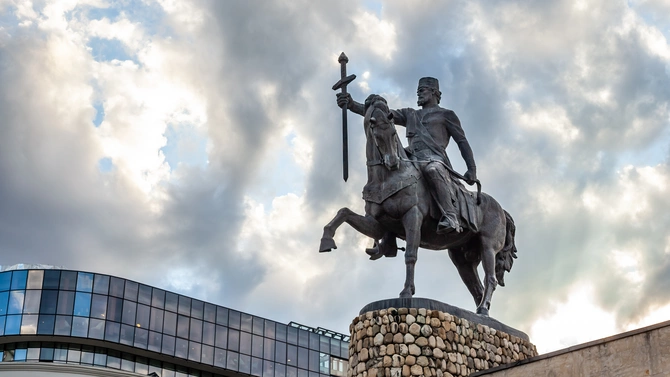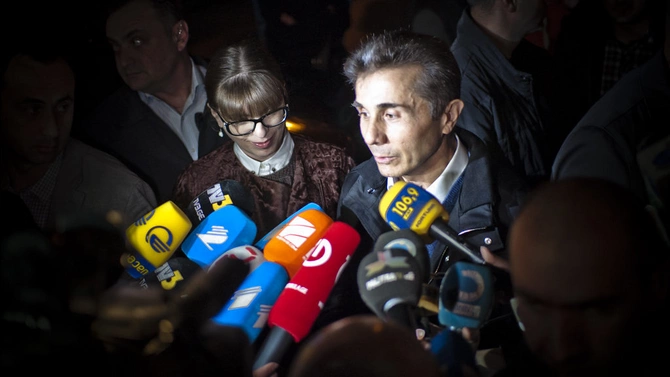
The relationship between Georgia and Russia has been a long and tumultuous one. Alexander Davitashvili takes a personal look through the history of the countries’ interactions and comes to his own conclusion.
Anti-Russian march and demonstration in Tbilisi, Georgia. June 29, 2019. Image: Cornelius_brandt/Shutterstock
One of the first historical sources showing the affairs between Georgia and Russia reports the marriage of Tamar, queen of 12th-century, ‘golden era’ Georgia, with Yuri Andreevich Bogolyubski, Lord of Novgorod (in Georgia, he was known as George the Russian). Bogolyubski had been expelled from his homeland for murder. His function on the Georgian Throne was to lead the army during wars; Tamar performed the other regal duties involved with governing the kingdom. However, the couple did not get along, and soon Bogolyubski was banished again, this time to Constantinople – taking with him lots of assets. Different Georgian sources give a wide variety of explanations for his fall from favour: that he was addicted to alcohol, that he failed to give Tamar a child, that he cheated on her with men. Perhaps all were true. After the divorce, George the Russian tried to seize power twice, but both attempts failed. This first bad experience put relations between the two countries on pause for the next three centuries.
By the 15th century, Georgia was divided into several smaller kingdoms. One of these, Kakheti in the central South Caucasus ruled by Alexander I, asked help from Ivan III, Lord of Moscow, to unite forces against resurgent Muslim invaders. But Ivan refused to help. This terminated relations for another hundred years. In the 1550s, the new King of Kakheti, Levan, addressed the same request to Ivan IV. This time Moscow agreed to help by sending 500 soldiers. However, the small force was rapidly recalled to Russia after diplomatic complaints from the Persian Shah. The same happened to Levan’s son, Alexander II, who – despite having given an oath of allegiance to Russia – was rewarded by just a token entourage of diplomats and priests rather than defensive aid.
One of the biggest disappointments in Georgian history was the signing of the 1783 Treaty of Georgievsk. By this stage, Kakheti and Kartli (central Georgia) had combined as a single Georgian kingdom under Erekle II. But dangers were evident on all sides: from Persia to the east and south, the Ottomans to the west and Orthodox Russia to the north. It’s an impossible situation immortalized in the classic poem “Fate of Georgia” by Nikoloz Baratashvili. Erekle II decided to side with Russia, gambling that in signing the 1783 Treaty, he would guarantee Georgia's territorial integrity. Russia responded by sending two ‘permanent’ Russian battalions of about 2000 soldiers. ‘Permanent’ ended up meaning four years: Russia recalled them at the start of the Russian-Ottoman war in 1787. Yet, in recognizing the supremacy of the Russian emperor, the treaty restricted Kartli-Kakheti from ever pursuing an independent foreign policy.

King Erekle II was the King of Kartl-Kakheti. A monument to him stands in Telavi, Georgia. Image: k_samurkas/Shutterstock
The worst of many Russian violations of the treaty came in 1800 when Tsar Paul I proposed to make Kartli-Kakheti a territory of Russia. Despite protests from British and French embassies, Georgia was absorbed into the Russian Empire the next year – and would remain under Russian control until 1917.
Russian dominion was a double-edged sword. The Georgievsk Treaty abolished the autocephaly (i.e. spiritual independence) of the Georgian Orthodox Church, subordinating it to the Russian Patriarch. However, notable Georgian family members gained experience serving in the Russian army, and the Georgian elites accessed broader modern education in Moscow, St Petersburg and beyond. Ironically it was mostly those who had studied in Russia who established a movement aimed at modernizing the Georgian language and encouraging its teaching back home. The group’s name, combining the words Tergi (the river that forms the Georgia-Russia border) and daleva (to drink), was “Tergdaleulebi” – i.e. the drinkers from the Tergi, an allusion to being educated in Russia. This movement is now considered a cornerstone of Georgia’s eventual independence. Its foremost leader was Ilia Chavchavadze, a figure so significant that he would one day be canonized as a Saint by the Georgian Church… after he was murdered. His words “Homeland, Language and Religion” still form the three pillars of the Georgian nation today.
Amid the maelstrom of WWI, in 1917, Georgia was finally liberated, the Russian Empire having fractured after two revolutions. The country declared independence and established a parliament, government, court, and constitution. It forged diplomatic relations with the west, the UK expressing particular interest in the newly re-established nation as they were interested in exporting Azerbaijan’s oil resources through Georgia. But independence proved to be short-lived. In 1921, the Soviet Red Army entered Georgia, and Russian occupation returned. The Georgian Church had initially regained its autocephaly (spiritual independence). Later, however, Stalin (himself born in Georgia) decided to abolish the “cult of God” altogether right across the USSR. During the purges that swept the Soviet Union in the 1930s, countless Georgian intellectuals were either executed or sent to Siberia. As the decades wore on, conditions within the USSR might have seemed less oppressive, yet in 1978 Moscow decided to abolish Georgian as a national language. Imposing Russian as the only language in Georgia led to protests in Tbilisi. On April 14, 1978, approximately 100,000 Georgians gathered to rally against the decision and, for what was probably the first time in history, the Soviet Union backed down. Another landmark moment for Georgia in its struggle to maintain an independent identity.
A remarkable Richard Shafiev drum solo starts this 43 minute Russian-language documentary about the 1980 Tbilisi Rock Festival.
Two years later, Georgians further asserted themselves when Tbilisi hosted the USSR’s first Rock Festival. Such music had been prohibited in the Soviet Union for being “culturally corruptive art coming from the west to destroy communism.”
However, a decisive turning point leading to most Georgians losing any remaining faith in the USSR was the 1989 April 9 Tragedy. Approximately 10,000 people had gathered on central Rustaveli Avenue in Tbilisi under Merab Kostava and Zviad Gamsakhurdia. They were protesting growing separatism in the Abkhazia Region and demanding independence for Georgia from the Soviet Union. The Russian-led Soviet army brutally broke up the demonstration: hundreds were injured, and 21 lost their lives, including 17 women and children. Exactly two years later, the Georgian Supreme Council declared the restoration of independence, for which, in a referendum, over 99% of the population had voted. The day is celebrated in Georgia annually as a symbol of National Unity and necessarily reminds many Georgians of the problematic relationship with Russia.
While Georgia was celebrating independence, Russia was exploring opportunities to maintain its influence in Georgia by raising tensions in the Autonomous Republic of Abkhazia and the Tskhinvali Region (so-called South Ossetia). These areas have been referred to as Soviet “landmines” left in Georgia as it was the USSR that granted them Autonomous Republic status (in 1931 and 1922, respectively), sowing the seeds of potential separatism. And in the post-Soviet period, this separatism was actively pursued. To achieve this, they sought Russian help - and threw out more than half a million ethnic Georgians from their homes. These folks fled to territory controlled by the Georgian government, becoming IDPs (internally displaced persons).
Russia maintained four military bases in Georgia, ostensibly justifying them as guarantors of ‘peace and stability.’ A 25-year agreement signed in 1995 envisaged Russian help achieving Georgia’s territorial integrity. However, it rapidly became clear that Russia did not intend to help Georgia with anything. Starting from the end of the 1990s, Georgia’s second president, Eduard Shevardnadze, began efforts to reduce Russian influence through negotiations to withdraw troops, a slow process only completed in 2007 under the new government of Mikheil Saakashvili. By this stage, relations were hitting rock bottom in other fields. Starting from 2006, Russia had started implementing an economic blockade with an embargo on two of Georgia’s most important exports: wine and mineral water. In tit-for-tat responses, Georgia detained four Russian officers, then Russia cut off all postal, road, air, sea, and rail connections.
On November 24, 2006, two explosions hit a gas pipeline in South Ossetia, the blast cutting off Russian gas supplies to Georgia and leading to an energy crisis in the country.
Tensions between Georgia and Russia finally boiled over in August 2008 in a five-day war. Tanks rolled into Georgia, and though they ended up withdrawing from much of the country, the conflict finished with Russia recognizing the breakaway republics - Abkhazia and South Ossetia – as independent states, reinforced with Russian troops. Meanwhile, diplomatic ties between Georgia and Russia were severed.

Sometimes referred to as “Moscow’s ‘informal governor of Georgia,” Bidzina Ivanishvili is pictured here at the Georgian presidential election in 2013.
Russo-Georgian relations have been a hot topic of discussion since the 2008 war. Political parties try to attract supporters by accusing each other of being pro-Russian. Thus the ruling Georgia Dream party has called Saakashvili an “agent of Russia.” Meanwhile, the main opposition party has portrayed Bidzina Ivanishvili, the founder of Georgian Dream, as a “Russian oligarch” and Moscow’s “informal governor of Georgia.” Despite a certain softening of foreign policy towards Russia after the change of government in 2012, the countries still do not maintain diplomatic relations. The only direct negotiations between Georgia and Russia have been the Abashidze-Karasin talks, where Zurab Abashidze acts as the Georgian Prime Minister’s special envoy. Discussions mainly cover trade-economic relations and nothing more (at least officially).
The level of distrust towards Russia from average Georgians was clearly demonstrated in 2019 when the Gavrilov Affair led to massive street protests. To the outside world, that might have looked an enormous overreaction – after all, the cause was simply that a Russian MP had been allowed to address the Georgian parliament while sat in the speaker’s chair. However, if you’ve read the article this far, you might understand. Trusting Russia is always a challenge if you’re Georgian.
Share on social media